page 23
Progressive Thinkers as of 5/8/2020
|
| ||||||||||||||||||||||||||||||||||||||||||||||||||||||||||||||||||||||||||||||||||||||||||||||||||||||||||||||||||||||||||||||||||||||||||||||||||||||
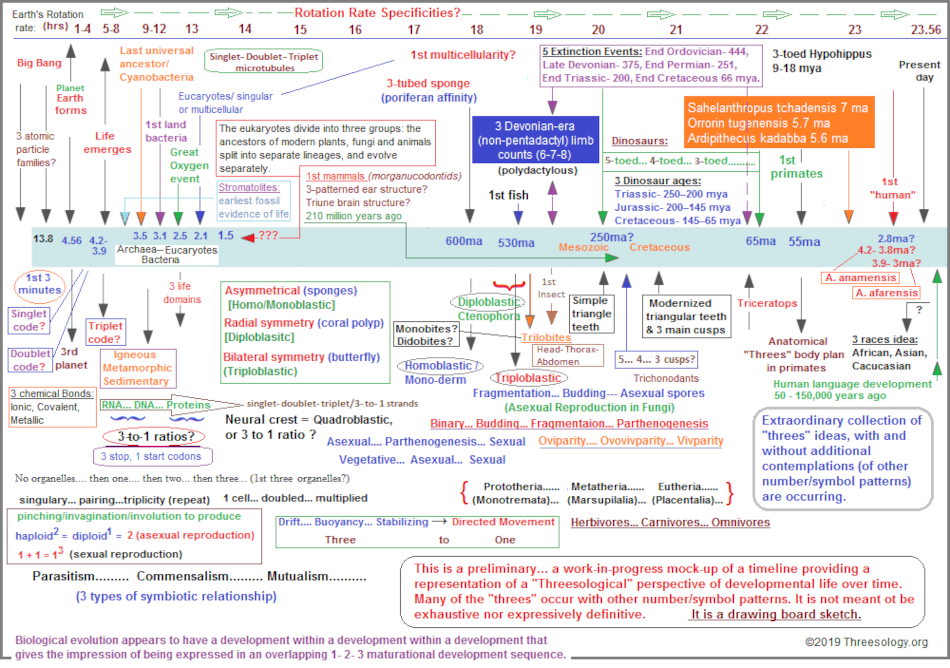
For the present context, let me say that no one has yet written the definitive tale of "threes" because one can provide a sentence, a paragraph, a chapter, a book, a series of books, a play, a movie with or with sequels to the occasion of a "threes" topic such as the following image captures a handful of three's events pertaining mostly to non-human activities, that is... other than the human participation of creating such three-patterned categories assumed to be truthful observations of reality. For example, humans claim to be on the third planet from a source of solar irradiation. Is this true, or is it but a modernized rendition of those multiple three-pattern myths and fairy tales so many of us have come across in one or another source? Indeed, why has the mind of many humans preferred to use a count of One god (monotheism) instead of two or multiple gods? Why the different counts between one and many, unless collectively these views bespeak of a primitive counting methodology that the general statement of "one- two- many" can be used as a preliminary tool of identification of multiple forms of cognitive activity using this three-patterned formula as a standard cognitive activity.
Let us not overlook that the phrase "one- two- many" is a three-word succession that one might replace with symbols such as 1- 2- 3; though we might well indulge in variations such as:
- A- B- C
- X- Y- Z
- Monad- Dyad- Triad
- primary- secondary- tertiary
- first- second- third
- small- medium- large
- manager- assistant manager- third man
- {0- 1- 2, 2- 3- 4, 3- 4- 5, (etc.)]
- upper- middle- lower
- Master- Journey man- Apprentice The Apprenticeship Model: A Journey toward Mastery by Christopher Perrin, Jan. 12, 2017
- here- there- everywhere
- a little- more- a lot
- Jan- Feb- March...
- yesterday- today- tomorrow
- 24 (hours a day)- 7 (days a week)= 365 (days a year)
- slow- medium- fast
- 1st- 2nd- 3rd reading (legislative activity)
- etc...
It doesn't matter if you think such a (three) pattern in one form or another is stupid, silly or common nonsense. The fact that such a pattern continues to crop up in multiple subjects is a cognitive pattern whose existence is being denied by multiple cognitive scientists. The same thing for other patterns being reduced to enumeration. If we didn't reduce our thoughts to enumeration, we would not have a computer code. We would not have a numbering system. We would not have social security numbers, driver's license numbers, sports records, economics, and multiple other facilitated ideas including the existence of a keyboard which is a go-between us and the underlying system of electronics used to translate electrical impulses into desired letters, symbols and images. Whereas cognitive scientists claim they want to amass ideas from multiple subject area, the topic of using a "threes" idea as a tool is like asking someone to use a knife, fork or spoon instead of chopsticks.
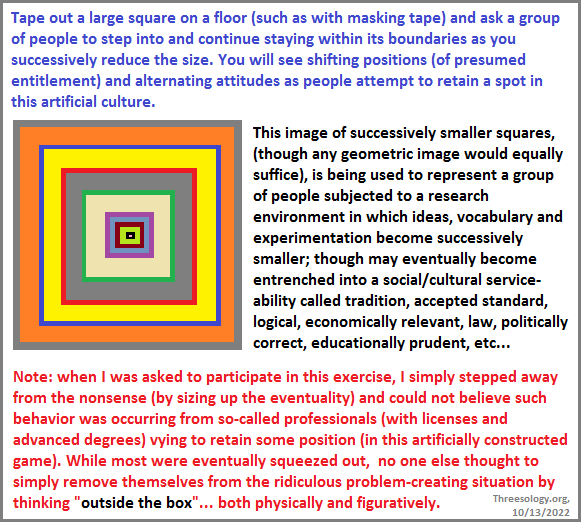
They don't use it because they are stuck in what may be referred to as a "collecting threes examples" mode of contemplation from which nothing has emerged to fulfill some desire to transgress into another territory of discovering— a more fundamental cognitive pattern adaptable to some selective venue that is at present stuck in the muck because everyone interested in the same topic in the same way creates a cul-de-sac of thinking and experimentation. It reminds me of the old game in which a square (or circle, triangle, etc.,) is taped out onto a floor and everyone is asked to get in it while it is successively reduced. Then the taped area gets smaller much in the manner in which ideas and vocabulary become restricted (condensed, abbreviated, symbolized) to a specialized view by so-called reigning authority figures. Then successively, the area is made smaller and smaller while the participants begin to act out instincts of self-preservation and begin eliminating those that they can by "politely" pushing and shoving (readjusting, reaffirming, reinventing themselves) so as to insure they have a spot... a position that they have knowingly or unknowingly sacrificed others for (in some cases to be called "collateral or reverberation damage"). Such an event takes place in all genres of interest, whereby selective... ideas and vocabulary are used to define a type of thinking which evolves as the preeminent illustration of a given perspective ... and sometimes represents a stuck-in-the-mud orientation where participants offer various excuses for lack of progress, such that new technology is needed... and yet along with such a technology they do not also describe the need for a new way of thinking... which they are unable to provide because they have found some niche in the increasingly narrowed field of pursuit.
What the above examples of sequences are referring to is a type of memory being used for/by a type of cognitive activity. This is not meant to imply that all types of memory (that is other than human), will exhibit such a sequence. Because such a big deal is appropriately directed towards a study of memorization, it is of need to note that some researchers are more rigid in their thinking than others who are practiced with a spectrum of cognitive flexibility. A short review about the consternations which can arise by those searching the internet for literature on the topic of memory, can be found here: The 3 Major Types of Memory And Every Subtype: A Complete Guide by Anthony Metivier, Sept. 27, 2022. An article referencing the debate on how memory is classified can be found here:
If in thinking about a Standard Model of Cognitive activity we come to assert that such a contemplation needs also to have a standard model of memory, which labels do we use? Labels from psychology? How about physics or chemistry or biology, or engineering, or architecture, or music, or art, or sports, or gaming, or cooking, or those which parallel some existing formula of dissection such as the Core- Mantel- Crust of the Earth or the transitions of development (called metamorphosis) seen in insects and labeled as 1) Ametabolous 2) Hemimetabolous 3) Holometabolous. Perhaps memory follows a circuitous path of birth- life- death... (renewal/regeneration/reincarnation)... birth- life- death, or can be referenced in terms of Heaven- Purgatory- Hell, or some 3 to 1 ratio configuration. Indeed, let us ask point blank: which type of memory best explains the type of standard cognitive idea you support? A mechanistic type of memory? A interactive chemical-like formula? A transitional solid- liquid- gas transition and transmission? Or how about the terms Reflection- Refraction- Diffraction? Or perhaps your preference is for a one-up-man-ship organizational methodology whereby if someone says one, you say two, and if someone says three, you say four or more? If someone gives three categories, you are inclined to add supplementations or gradations similar to the sizing of clothes?
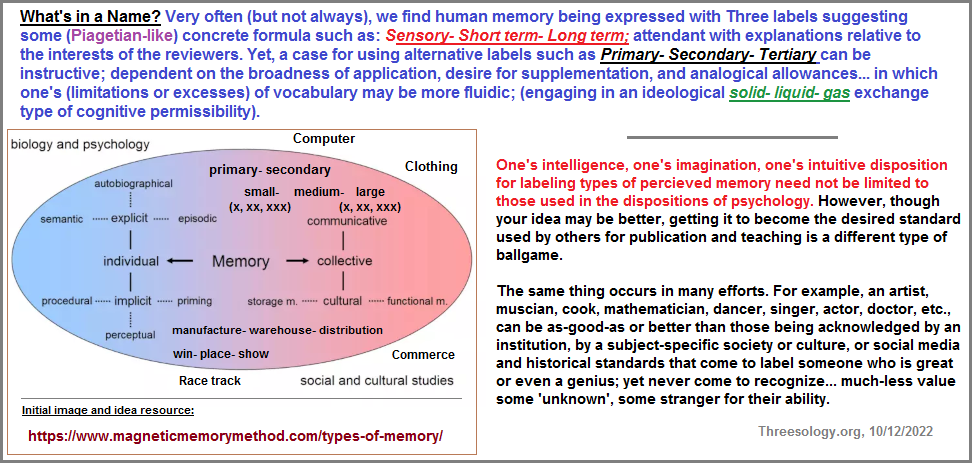
Because the words "cognitive" and "mind" are sometimes used interchangeably to describe activities such as consciousness, mental activity, thinking, and thought processing; one might consider this to mean the following 3 references will necessarily overlap in their definitions... for example:
- "Standard Cognitive Model" (as being described here) Use of a patterns-of-three tool in contrast to or in context with other patterns which may not be enumerated, in order to identify recurring cognitive patterns by presence, intermittence, and absence.
- a "Common Model of Cognition" by Peter Lindes. This idea references the use of finding commonalities (commonly occurring) patterns by way of the language/mind interface (Philosophy of Mind, Language, and Epistemology ) that has had a long-standing philosophical presence just as the Body/Mind duality (typically noted in the fashion of Mind-Body dualism.).
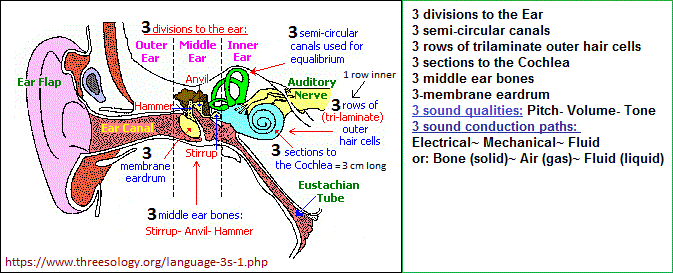
The conceptualized "Language/Mind" duality needs to progress to an active realization of a triplicity, perhaps stated as "Language- Hearing- Mind", because the process of hearing needs to be addressed as a collection of patterns affecting how we hear and thus affecting thoughts. Because it is so well-known that a deaf (or hearing impaired/ hearing challenged) person does not learn to articulate well and that because of this some types or portions of thought processing, compilation, experimentation, etc., can be affected, a look at repeating ("common") patterns associated with the Ear needs to be included in the overall discussion. By recognizing the presence of a repeating pattern-of-three and then come to identify repeating patterns-of-three in both grammar and linguistics (for example the Subject- Object- Verb Word Order idea); and recognizing that experimental ears with sets of different patterns can be constructed by engineering departments to facilitate proofs; we have a means to take the study of the Language/Mind idea into uncharted territory.
- (Use this Search criteria): "A standard Model of the Mind Toward a Common Computational Framework" by John E. Laird, Christian Lebiere, & Paul Rosenbloom
However, the former (1st item in the above list) as I am using it relies on numerical (and sometimes geometric indicators) while the 3rd example apparently indicates its authors are directing their efforts 'foremostly' towards a computerized/robotics/ (artificialized) application. (Simply put, our approaches towards studying and the intended application thereof are different.) The latter (3rd item in the above group) has developed their application with an image expressing a: Cognitive Architecture illustrating what appears to be electrical circuit- driven intenationalities proscribed by two-patterned (module/buffer) reference sets around/nearby a 3-patterned conceptualization of a 3-part labeled interface: 1) Matching (striatum) 2) Selection (pallidum) 3) Execution (thalamus). While there is nothing wrong (per sey) with the model, it lacks the qualification of examples from real-world human cognitive activity from multiple subject areas being revealed by using a basic system of enumeration. (The architecture is like a selective blueprint for a given type of fuel-driven motor/engine to be used in a given type of vehicle for a given type of race, and naming it a "universal" representation.) It is difficult to have a common or universal cognitive model illustration without giving an account of repeating cognitive patterns (as well as the repetition of absence of a given pattern).
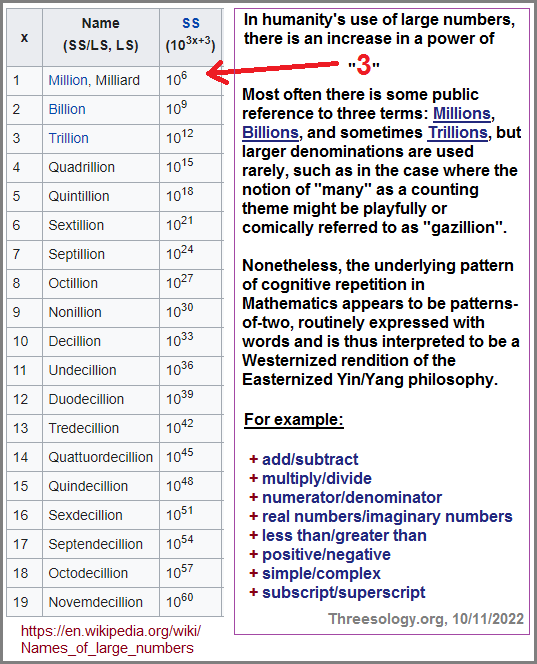
In other words, their cognitive model should display our recognition of patterns which (in the present case of discussion) uses enumeration in multiple guises, and where numberless cognitive expressions do occur, these are translated into representative numerical indices which parallel the physiological activity. (For example, we are aware of a bipedal gait, but do not customarily reference it as a duality, dichotomy, pattern-of-two which may influence or be influenced by a parallel cognitive patterns.) As for the second listed example in the foregoing list of alternative Cognitive Model research efforts, I do not see an effort to include a recognition of patterns found in hearing as well as language, as for example, are described here: Language Threes page 1. An example of this is the need for understanding the presence of and illustration efforts such as the tripod gait of insects being used in robotics design. We take for granted that it is we humans who are referencing a "tripod" gait while insects express such a pattern without the use of symbols or words describing a "three" pattern.
No three-partitioned (Head- Thorax- Abdomen) insect that I know of is explicitly referencing their preferential usage of a "three-pattern" as a repetitive exercise as interpreted by human cognitive activity that involves values of memorization being spoken of quite often in cognitive modeling discussions, but are routinely absent of speaking about repetitive patterns to be found in the process of hearing; despite the lack of which humans would have difficulty in verbal articulations that some philosophers describe as a direct influencer of thought processing and idea generation. No less, we do not find plants referencing the mnemonic "leaves of three? Leave them be!", as a reference to poison Oak, Ivy, and Sumac. Whether one would like to get into a (metaphysical) discussion of whether or not an insect has some species-specific "cognitive" activity aligned with physiological movement or not, the point remains that we humans recognize and have organized some robotics architectural efforts based on a tripartite model orientation. If the human mind has some internalized predisposition to see many things in "threes", this could be both a blessing or curse if cognitive efforts should be directed towards the use of some other pattern model.
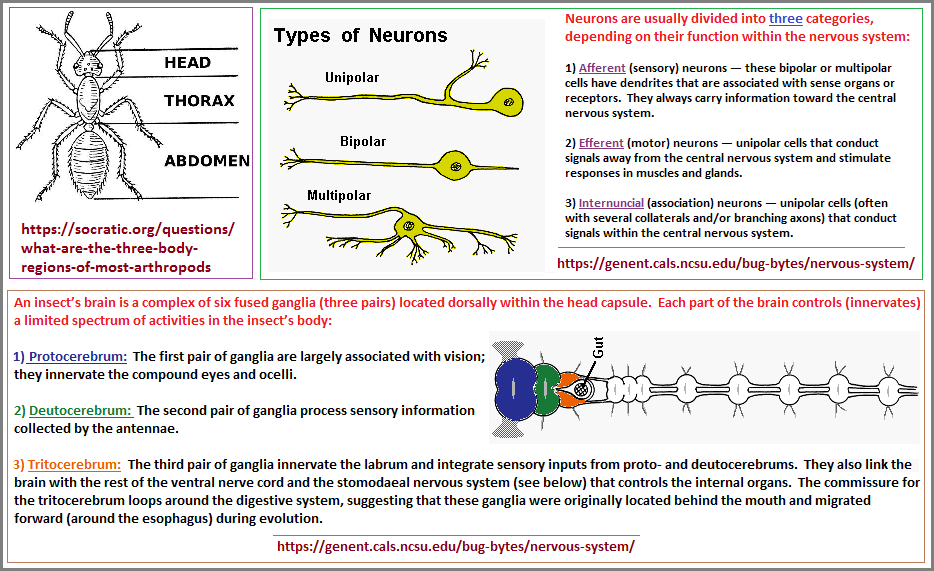
For those who give "an account" of some subject, your mind should reference such a phrase as the person going to provide you with a "Count" of a subject in a numerical sense, whether or not they do this intentionally, with a deliberated attempt not to use direct number identifiers, or are oblivious to such an activity, though they may routinely exercise a habit of enumerating pages, chapters, a bibliography, etc... That's right, they are providing some sort of counting methodology they use in "recounting" a topic that they may well abbreviate at any time for a particular time, place and assumed audience they are playing the part of an Accountant, whether or not they are aware of this or even use any specific numerical references. For example, a person may give their account of a topic such as the idea of One god. And much like a primitive person using a stick, bone, rock, shell or the ground nearby, they reference their "one" reference like individual notches seen on a tally sheet you may not even acknowledge being kept. This same person who had first reference the ONE god, may then exhibit a cognitive assignment of enumeration beyond the concept of one or singularity, by giving an ac-ccount of two by way of pairing, such as by referencing the notion of good and evil or heaven and hell or God and Satan, etc... However, instead of providing what many of us would expect in a successive counting method of 1- 2- 3..., they may instead think in terms of the more primitive "many", whereby after the "2" (by way of pairing), they may express numerous examples of what they may think are references to limitlessness, or some great quantity such as a long lifespan, or Eternity. In their "ac-count", they are using the counting methodology of the primitive's "one- two- many" counting scheme/theme.
Another example of an "a counting" methodology as an expression of a cognitive development that a person or a given community shares, is the adoption of a highly developed sense of pairing such as in the case of the Yin-Yang idea, of which the Male and Female duality might be seen by some as an opposition, while others view as a complimentary (complementary) duality, dichotomy or couple. Since human sexuality has produced multiple cults referencing an obsessive orientation to this observation, the male/female pairing should be placed first on a list of alternatively paired associations by which to establish a large accounting of the "two" idea. For example, the following lists are representative of this two-patterned counting method:
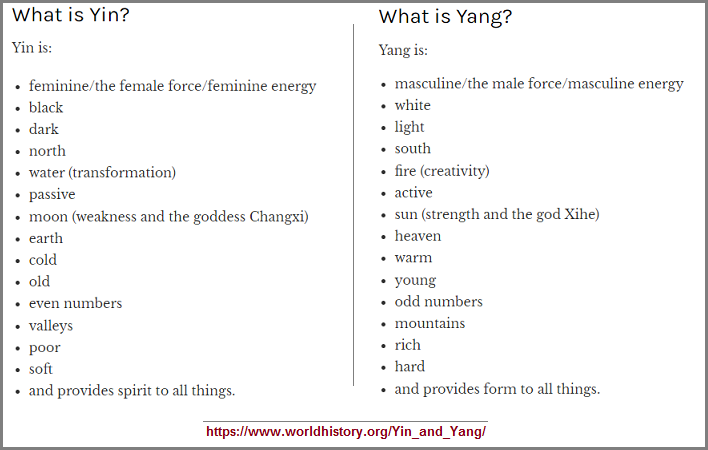
Yep, the East was ahead of the west in developing an elaborated model for conceptualizing that recognition of a count of "2" had been reached. The West, for the moment, was lagging behind in its development of a higher counting sense. In moving onto the successive concept of "3", the Chinese developed the idea of the I-Ching which promoted the ideas of Triads. However, what is often overlooked is that this cognitive attempt to express an effort to illustrate a higher sense of counting was leashed, was chained, was enslaved to the previous use of the pairing method... whereby the triads were constructed on references to the earlier Male and Female obsession of acknowledging sexuality, whereby the triads were constructed by using a single like to represent the male (penis) and two lines to represent the female (vagina). There was not third gender nor even the notion of neuter, like that found in grammar, or the concept of zero to be found later in the development of Western cognitive activity for developing a higher sense of enumeration.
And so what does the West come up with as a type of (unrecognized) parallel to the early counting method developed by the Chinese in its usage of pairing? Low and behold a system of numbers develops from which arises a philosophy called Mathematics whose basic notions are a collection of paired ideas! Oh my gosh. Whereas the East used the yin and yang pairing philosophy of expressing a cognitive effort of reaching an acknowledge "two" count of developmental brain activity, to be followed by an attempt to reach a "3" level of cognitive counting that we can see was but an embellished pattern-of-two in the guise of an illustration labeled a triad that actually wasn't a "three" (in a developmental cognitive sense of brain maturation); the West developed an alternative two-patterned orientation called Mathematics... which itself is presently poised in the position of expressing attempts to reach beyond a predominant "two" orientation to establish a "three". Examples of this cognitive striving to reach beyond the "2" count to reach a "3" count show up in various guises. For some, the all too familiar attempt to develop a trinary (ternary) computing system to replace the present dominant binary system needs no elaborate explanation. However, Mathematicians struggling with the attempt to take their profession into a new era of conceptualization are having some difficulty because they are failing to recognize the predominant "two-patterned" structure which present Mathematics is built on. Attempts to develop, to reach a "3" point of conceptualization is at present much at the level that the I-Ching is with its embellished Dyads (biads) masquerading as triads.
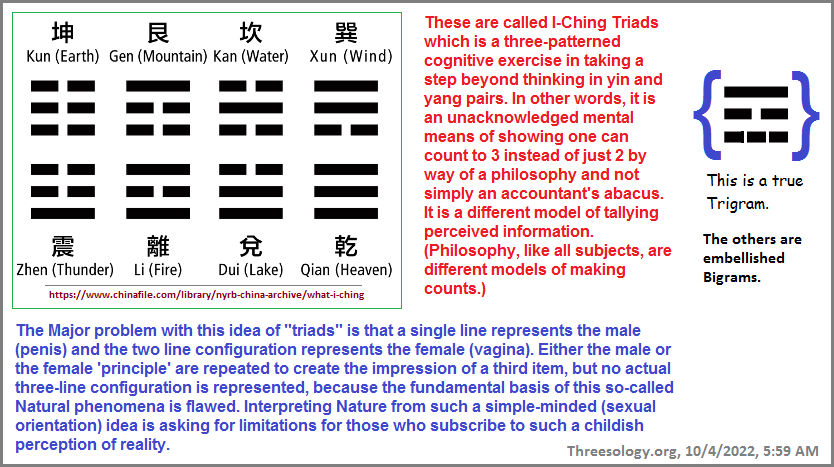
For those who either by hook, by crook or some adventurous look chance upon this page... let them be aware that I am interested in the "threes phenomena" occurring in multiple subjects. However, it does not occur as a dominant theme in some. For example, our present Mathematics apparently has a short leash on patterns-of-two, with a short list that should suffice for this introduction, though the short leash works much in the manner where one may question whether it is the person walking the dog or the dog walking the person (with a bipedal gait) influencing conceptualizations:
- add/subtract
- multiply/divide
- numerator/denominator
- real numbers/imaginary numbers
- less than/greater than (addition of the "equal to" idea presents us with a third category)
- two sides of an equation
- positive numbers/negative numbers
- simple/complex
- subscript/superscript
- Etc.../Etc...
Several Mathematicians are trying to transcend this "two-patterned" cognitive leash just as did early peoples in their efforts to conceptualize beyond the value of 1, than the value of 2 and then so on... with each transcendental achievement taking on some measure of completeness which expressed the cognitive limitation at a given developmental period of Mathematics from its early counting schemes and rhythms. A parallel attempt of this cognitive effort is taking place in computer development which strives to move from the binary computation to the trinary (ternary) computation. Unfortunately, while we make a step forward, two steps to the rear seems to be a recurring phenomena, as if the human brain is stretching its lungs but falls back to the comfort of the more familiar. This familiarity is a pattern-of-two that was well established in the East by the advent of the Yin/Yang idea. It is as if the present model of Mathematics is a Westernized elaboration of the old yin/yang attachment to dualities.
While this is not to say that Mathematics doesn't work particularly well as crude a tool that it is, it must be noted that those who are practiced working with crude tools (and underlying shapes/patterns) are quite effective at persuading observers their efforts are supreme expressions of humanity cognitive capability, but are also adept at camouflaging the primitive crudeness of design. But let me now get back to providing some more "threes" examples:
The threes phenomena is a repetition of a pattern-of-three such as for example we can observe most people using three fingers (two fingers and 1 thumb) to hold a pen or pencil. This activity is a standard, and may in fact be a world-wide standard most of us take for granted. Another example is the line, box and X in the upper right hand corner of a computer screen. This too is standard. It is also standard to see people with eyes that have a pupil, iris, and cornea. In fact, if we look closely at human anatomy we find that patterns-of-three occur with remarkable frequency, as note by Dr. McNulty in his List of Threes in Anatomy.
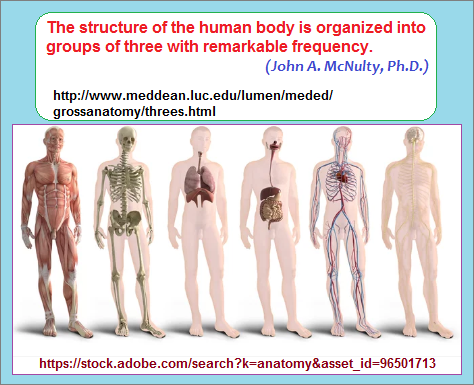
If we then turn to a subject such as Physics as Mark Mahin has done, a regular occasion of "threes" is evident: Nature Seems to Love the Number Three.
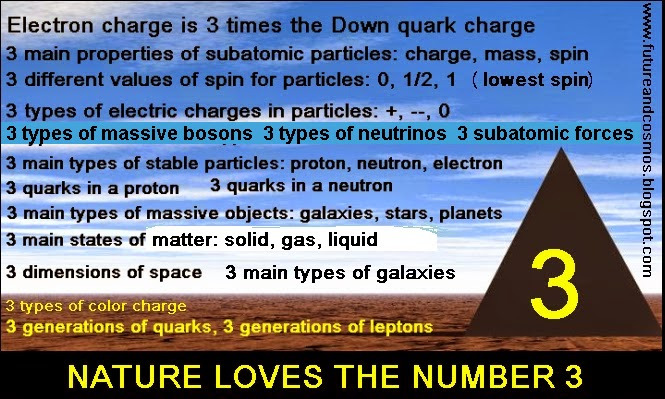
Let us not also discount the idea that in the beginning of the Universe, there were three elements based on an identification of chemical fingerprints by way of chemical tracings, (that I interpret to be) like finding an impression of a printed script on a notepad by brushing across the surface of the underlying page, as seen in multiple detective stories. The three elements are: Hydrogen, some Helium and a little bit of Lithium.

And let us add to the above a reference to the three generations of atomic particles:
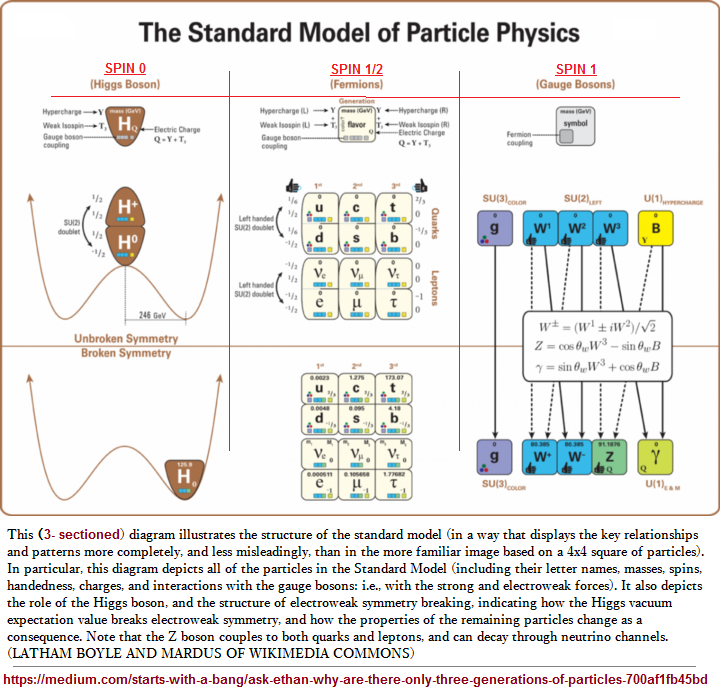
Let us now add a reference to Cosmology involving the three theories as to the shape of the Universe, (How the Earth and moon formed, though there are references to more than three ideas such as this: Theories of Formation for the Moon):
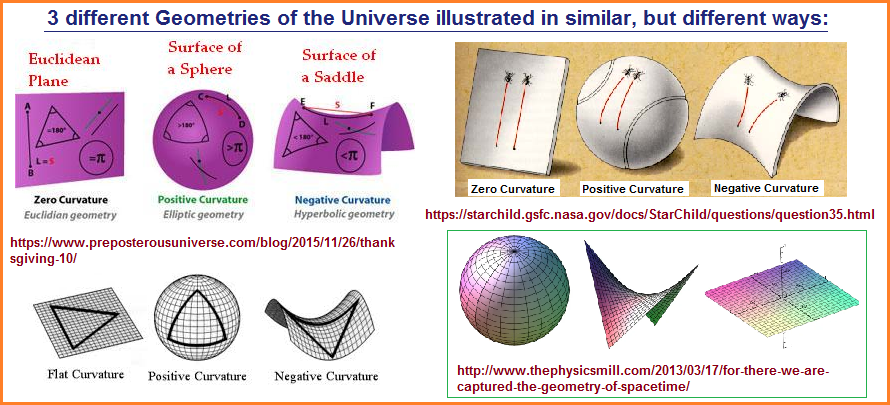
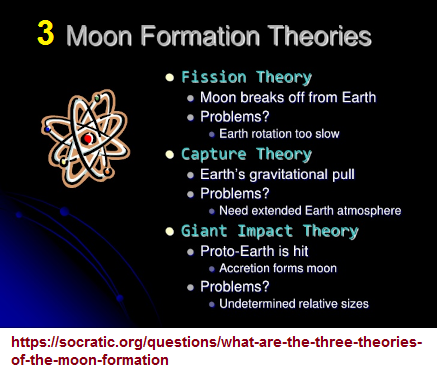
With respect to the formation of the Moon, the most widely accepted theory is that it was created by a Giant Impact. If we add three other ideas, we have a 3-to-1 ratio which is a cognitive pattern discussed a bit more here: (Standard Cognitive Model pg. 21)
- the moon broke away from the Earth ("Fission theory")
- the moon formed elsewhere in the solar system and was captured by Earth’s gravity ("Capture theory”)
- the Earth and moon formed from the protoplanetary disk at the same time ("Co-formation")
Alternatively, the idea of three dominant Moon formation theories (Fission, Capture, Collision) can be displayed in the accompanying image. However, it should be noted by those with an interest in Sociology, History, and Cultural Anthropology that the words "Fission, Capture, Collision" describe how civilizations both rise and fall. Some groups splinter off (Fission), others grow by accretion (Capture) such as by way of slavery or groups joining together; perhaps due to shared values, marriages, and/or commerce, and by Collision, the infamous character known by many names such as War, strife, famine, disease, etc...
With respect to the overall generally described divisions of the planet Earth, we see that our skin layering exhibits a similarity, or at least a similarity in the way our brains process information and collates it:
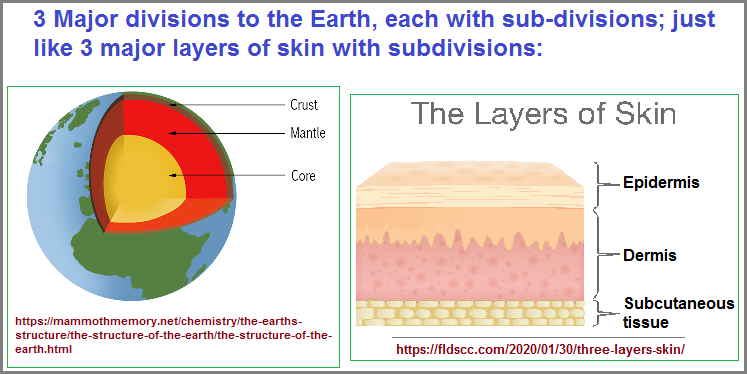
The idea of the Earth having three layers can be compared to a fruit with 3 layers and then apply psychology to this:

And now that I am on the subject of fruit and from this to plants in search of "threes" references:

An uncommon correlation made with respect to trees is that my perspective I see three large categories spread out over terrains involving elevation. While there are occasions for humans to transplant different types of trees from where they originate or dominate a landscape to another where there are few examples, there are multiple examples which provide evidence for the idea of a linear, circular, triangular succession. If you will excuse the crudeness of the accompanying image in my effort to provide a rather stick-figure like illustration, it is nonetheless not difficult to see that tree growth generally follow this pattern. We have linear-like trees nearer to sea level, more roundish or robust trees at slightly higher elevations, and the well-known triangle-shaped pine variety of trees at the highest elevations of tree dispersal. The Linear (line)- Circular (circle)- Triangular (triangle) configuration is an interesting theme of research because it leads into different subjects areas as represented here: Line, Circle, Triangle, pg. 1

If we turn to the subject of Philosophy with a particular focus on Logic, we find there are three fundamental laws as discussed by Yolanda Williams:
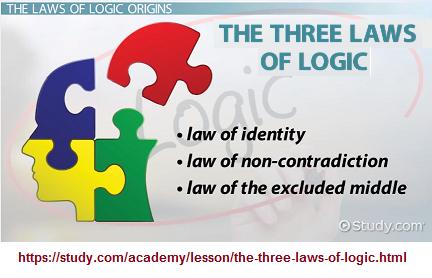
If we explore the topic of logic for just a moment, necessarily acknowledging we are speaking of Philosophical concepts whose range is far, deep and multi-faceted for such an interesting topic, let us note as a general sense involving a "threes" orientation, that many people consider Socrates, Plato and Aristotle to be the "Big three" of Greek philosophy, though opinions may differ for those whose philosophical interests lay in alternative directions. Nonetheless, we can contrast this "Western Orientation" of three with an Eastern Orientation of three, despite the lingering insistence by some that the two-patterned Yin/Yang philosophy describes all there is to know about life. Far too many overlook the developmental cognitive trend of Arithmetically-based succession which appears to mimic humanity's early attempts to develop a counting system to which one might ascribe the basic "1-2-Many" description, whether all primitive peoples used this model or not. The point is that when early Chinese peoples developed a usage for a two-patterned yin/yang ideology, the supposed succession to a three-part model labeled I-Ching triads were actually not a "three" but a transitional step towards a pattern-of-three conceptualization for which they did not adequately illustrate with the presumed Triads, because a true triad would be one which exhibited a single, a double and a triple line configuration, instead of just juxtaposing single and double lines grouped into threes, to give the impression of a cognitive achievement, when actually it remained attached to the primitive idea of a single line representing the male penis and the double line the female vagina, in keeping with a retention of the yin/yang dualistic composition related to male and female 'principles' of analogy.
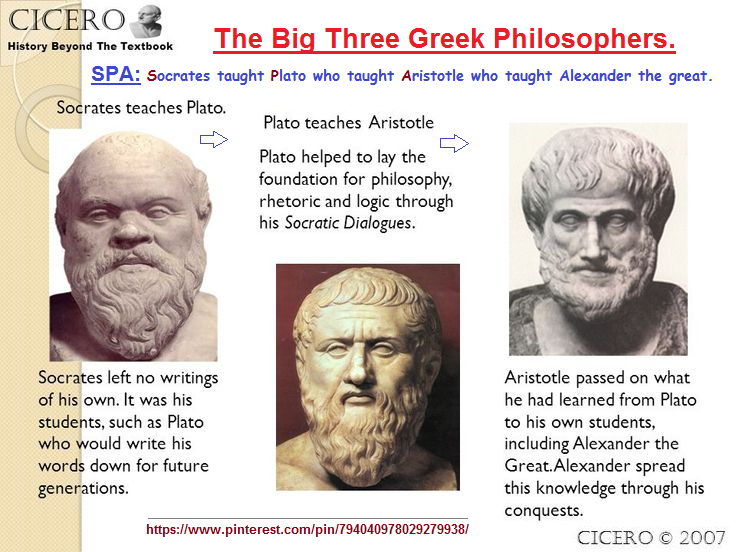
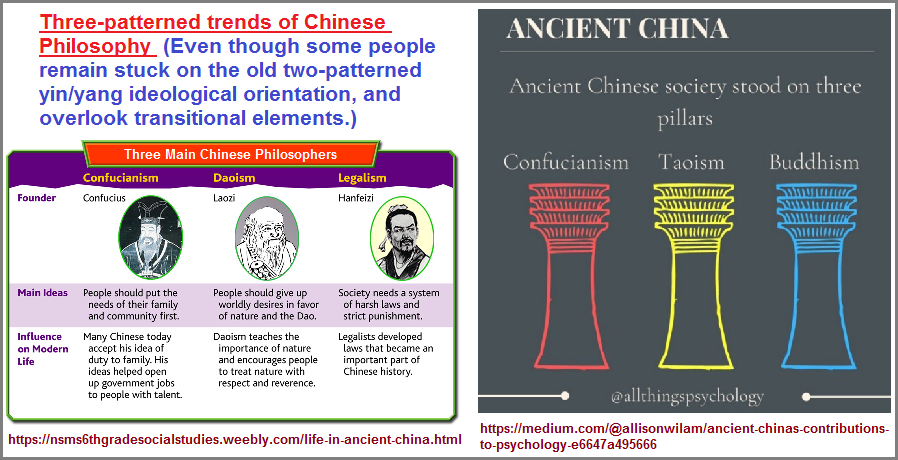

With respect to logic viewed as moving from a pattern-of-two (dichotomous viewpoint) to a three-patterned perspective, one might provide the example of the Aristotelian Square of Logic, where it had been customary to focus on the word "contradictory" instead of the placement of the three different terms "All- No- Some", particularly when Aristotle is known for using triads. The Square logic illustration reminds me of a mirror-imaging effect embedded in a portrait involving three characters, but observers are appreciably focused more so on the idea of a two-part contradiction, and not until the idea of an Algebraic-based boolean consideration does the square take on the labeled interpretation involving a three-part idea which already existed, but observers after Aristotle's time period emphasized a "two" orientation instead of the accompanying three-part characterization. Nonetheless, one can describe a trend in thinking from a pattern-of-two to a pattern-of-three... even if the basic illustration does not take on an appreciable change except in the manner of an associated interpretation.
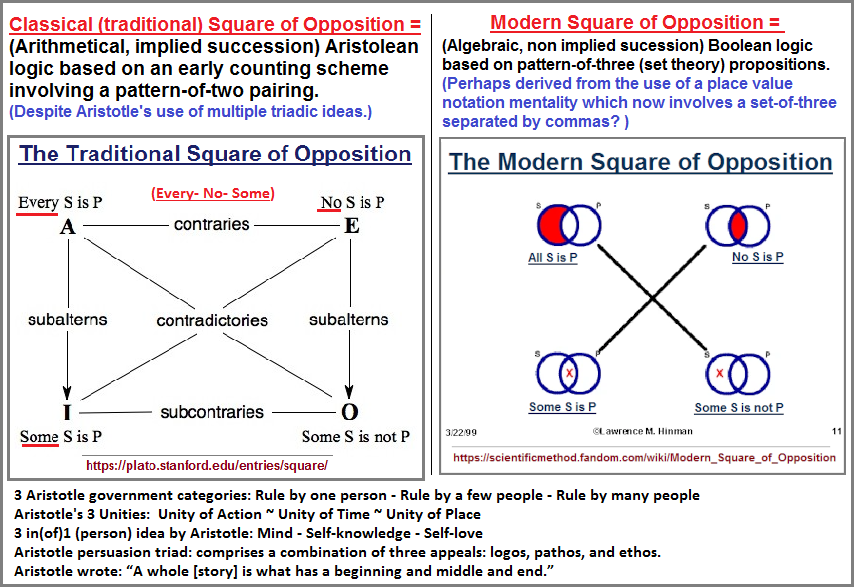
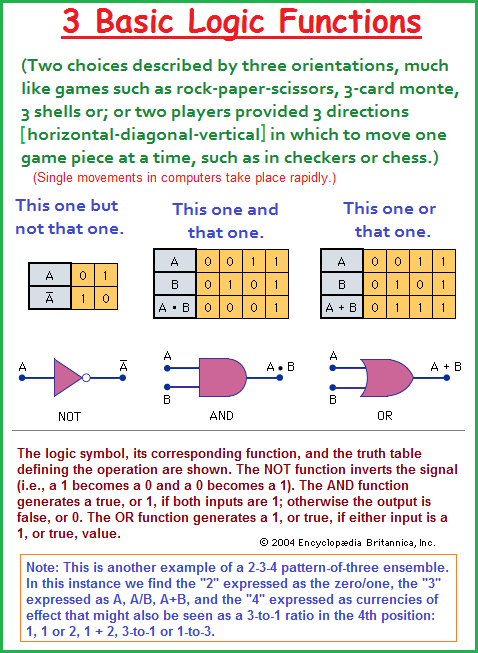
While it is presently customary to use a binary language for computers, there are those trying to develop a trinary (ternary) computing system. Hence the presence of the "two" orientation contrasted with a "three" perspective is seen in the logic of circuits. This idea of using a three-part illustration contrasts with the idea of using a square, found in a 4 X 4 illustration seen in) genetics, math, and particle physics as well as philosophy, which reminds me of the old 4-square game I used to play as a child, in which the configurations involved a set-of-three options involving 2 players, 3 players or 4 players. All of them show the basic 3-ensembled considerations that might be viewed as a basic cognitive patterning being repeated in different fashions, depending on one's interest. Some are more embellished and enumerated, but all exhibit a similarity.
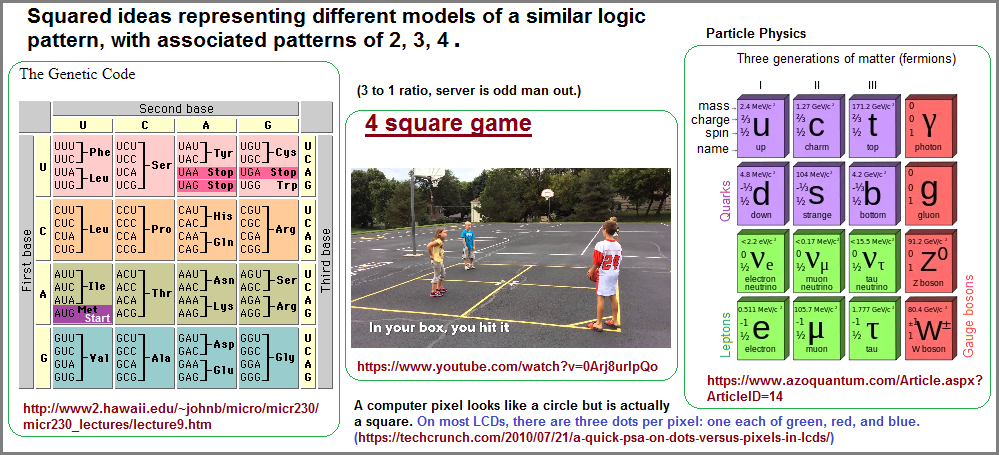

There are other examples of dominant or major three-patterned ideas in other subjects; for example from Astronomy, such as life existing on the Earth, 3rd planet from the Sun and from genetics we find a basic constituent of life known as DNA having a triplet code; and from a text book on developmental biology we find that complex life forms such as humans have developed by way of a sequence of Three Germ Layers labeled the Ectoderm- Mesoderm- Endoderm, which has been alternatively described by helpful ways to remember them, called a Mnemonic, as described by Trillium Chang (whose first name is highly appropriate for a "threes" discussion):
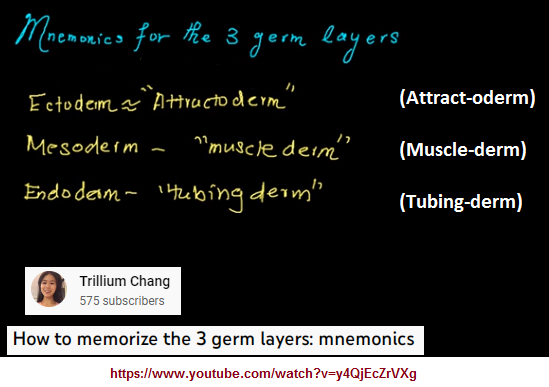
Apparently, all animals grow from Germ layers. If the have two Germ layers they are called Diploblastic, though the prefix "Bi" could be used if the research community was so inclined. The most complex organisms such as humans, grow from three Germ layers and are referred to as Triploblastic. Even though the term "Monoploblastic" is not typically used when referring to an animal with one Germ layer, I prefer to use it in the present context in order to more clearly differentiate the "one layer- two layer- three layer" differences. Hence, we have the following lineup:
- Monoploblastic (one Germ layer) animals: Sponges are the only animals that have a single germ layer. Sponges are the simplest of all animals, lacking true tissues (parazoa), muscles, nerves, and internal organs. Although they have differentiated cells (e.g. collar cells), they lack true tissue coordination. Sponges also are the only group of animals with true asymmetry. (New World Encyclopedia, Germ Layer)
- Diplobalstic (two Germ layer) animals: Diploblastic organisms are organisms which develop from such a blastula, and include cnidaria and ctenophora, formerly grouped together in the phylum Coelenterata, but later understanding of their differences resulted in their being placed in separate phyla. (Wikipedia: Diploblasty)
- Triploblastic (three Germ layer) animals: Triploblasty) can be seen
in multicellular animals, particularly:
- Flatworms (Phylum Platyhelminthes)
- Mollusks (Phylum Mollusca)
- Arthropods (Phylum Arthropoda)
- Chordates (Phylum Chordata), examples are:
- Birds: (vultures, chickens, ducks, geese, etc.)
- Mammals: (humans, felids [cats], canids [dogs], etc.) Mammals can be generally classified into three broad groups: egg-laying monotremes, marsupials, and placentals.
- Fishes: (sharks, mackerel, tuna, salmon, etc.) There are three superclasses into which fish are grouped: Bony fish (Osteichthyes), jawless fish (Agnatha), and cartilaginous fish (Chondrichthyes). Ray-finned fishes are of the class Actinopterygii, while lobe-finned fishes are of the class Sarcopterygii. Both are clades of bony fishes.
- Reptiles: (snakes, lizards, crocodiles, turtles, dinosaurs)
- Amphibians: (frogs, toads, salamanders, newts, and caecilians)
(Second half of this page moved to page 23)
Date of (series) Origination: Saturday, 14th March 2020... 6:11 AM
Date of Initial Posting (this page): 1st March 2022... 6:04 AM
Updated Posting:Saturday, 15th October 2022... 6:37 AM, MST; Albuquerque, NM.